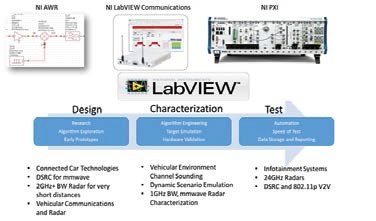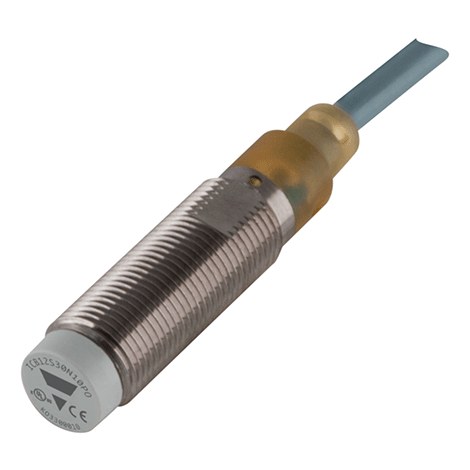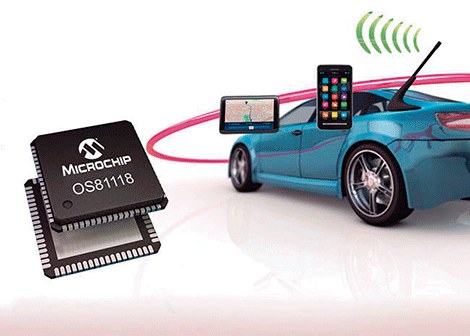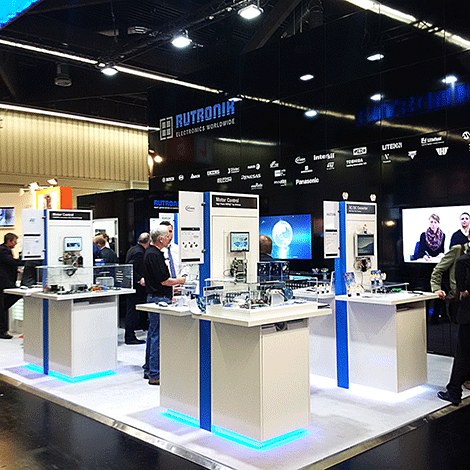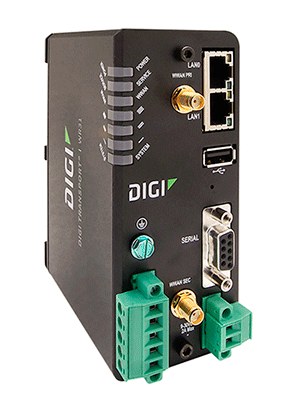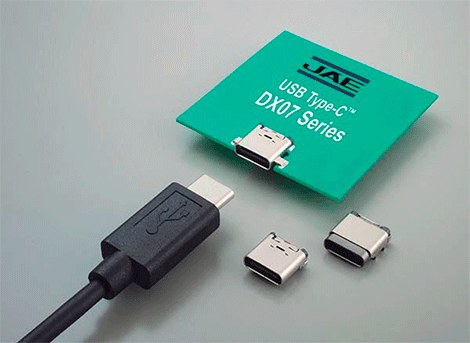Introduction
Emerging 5G wireless and mobile technologies are bringing another level of connectivity to cars and enabling many applications to support safety, efficiency and Internet access. The connectivity is a natural complement to other types of automotive sensors that are also being integrated into vehicles. Communication allows vehicles to exchange what they see and extend their detection range, improving automated decisions. As modern communications and radar technology is rapidly making its way into validation test and production plants, engineers and scientists are actively working on innovative ideas to better understand how automated cars will better interact with non-automated objects in the road, promoting synergy between communications and vehicular radar, and designing wide-bandwidth radars capable of resolving very short distances. To bring these technologies to market, the automotive industry must take advantage of a technique based on a software-centric platform that helps speed up the design, characterization and testing phases.
Trends in technologies connected to the car
Wireless communication is bringing another level of connectivity to cars. With wireless technology, cars can communicate with each other directly in vehicle-to-vehicle (V2V) mode, or via infrastructure in vehicle-to-infrastructure (V2I) mode. There are numerous connectivity applications to provide security, transport efficiency and, of course, Internet access. The connectivity is a natural complement to other types of automotive sensors that are being integrated into vehicles. Vehicular connectivity has been investigated for at least twenty years. The de facto technique is specialized short-range communication (DSRC). This technology is primarily conceived as a means of exchanging basic security messages, although it also has applications in traffic control. The DSRC supports V2V and V2I.
After nearly 20 years of development, DSRC now exists on some cars in the US, though its use won't spread without a government mandate. Automated vehicles are of all kinds, depending on the level of automation. At one extreme is non-automation, where the driver controls everything. At the other extreme, the vehicle is in complete control of everything and there are no controls for human assistance. At intermediate levels, certain driving functions are automated but the human can take control. For example, at a lower level of automation, the driver can be warned of a possible frontal collision. At a higher level of automation, the car can automatically apply the brakes and perhaps also perform an avoidance maneuver to avoid a collision. Although fully automated driving is often called “autonomous driving”, it is unlikely that full automation can happen simultaneously with full autonomy, implying no communication. The reason is that high-speed fully automated driving is difficult without high-resolution map data communication. Connectivity is a fundamental component of vehicle automation, as it improves the detection range of vehicles.
Sensors for automation include automotive radar, visual cameras, and LIDAR. Radar is used for automatic cruise control, forward collision warning, lane change assist, parking and anti-collision applications. Visual cameras are used for safe backups, blind spot monitoring, numbing avoidance, and lane keeping. LIDAR provides high-resolution 3D map information that can be used for autonomous navigation, as well as pedestrian and bicycle detection. All three technologies are important for fully automated vehicles.
For example, Tesla uses visual cameras for automated highway driving, while Google cars make extensive use of lidar and 3D mapping data for precise driving and navigation, and various radars to help detect other vehicles. The scope of each technology depends on its configuration and deployment case. For example, in rural areas, radar can reach 200 m, LIDAR 35 m and visual cameras 30 m, but in urban areas the range of all these technologies decreases several meters due to the obstruction of other vehicles. Essentially these external sensors are limited by what they can see. Communication allows vehicles to extend their detection range by taking advantage of what other vehicles in front, behind or to the sides can see. Mixed-use environments where vehicles have varying levels of automation and communication remain a challenge. One technique is to deploy detection at the base station, for example radar, visual cameras or LIDAR. The information derived from the sensors can then be transmitted to connected vehicles, giving them situational awareness about non-connected vehicles and non-vehicular road users.
The infrastructure-based technique has the advantage that it works well even if most other vehicles do not have the communication capability. The infrastructure will also make much of the automation more efficient, for example in coordinating vehicle interactions at junctions without the need for traffic lights. This infrastructure-based detection will likely build around 5G mobile communications as data speeds will greatly increase. There is currently enormous interest in the use of the car for 5G. Applications include vehicle automation, transportation planning and operations, and, of course, information and entertainment. 5G will support 10 times lower latencies and 10 times more bandwidth than 4G solutions, making it especially suitable for automotive applications. In particular, 5G millimeter wave is especially attractive because of the high data rates, which can be used to exchange raw sensor data.
Millimeter wave for automotive applications is one of several ongoing research topics at the University of Texas at Austin. Other topics include the co-design of communication and radar, the use of low-frequency communication signals as a low-cost means of automotive radar, and the use of sensing-based infrastructure to aid millimeter-wave communication. .
A platform-based technique accelerates innovation and shortens time to market
Typical engineering projects go through the design, characterization, and test phases. These phases are usually dislocated and each one has different tools and techniques. For development efficiency in each phase and a rapid transition to the next, NI offers a platform-based approach that lowers the barriers between each phase with a unifying environment through common, well-integrated hardware and software components. At the core of the NI platform is LabVIEW software. This platform-based technique speeds up productivity and reduces the time spent on each phase. Design: Engineers and scientists around the world are exploring various connectivity and sensing technologies, with a variety of carrier frequencies and with different bandwidths. Exploring synergies between communications and vehicular radars requires understanding the design trade-offs that are realized at the MAC and PHY layers.
To rapidly create prototypes for radar and communications systems, a platform must offer very high throughput and data transfer, especially to allow a prototype to work in real time under real world conditions. To offer these capabilities, a platform must have fast parallel cores, a high-speed bus for data transfer, or support FPGA processing capabilities, and of course, support advanced signal processing techniques. Based on the underlying hardware that offers these high-performance capabilities, the LabVIEW Communications System Design Suite (Figure 2) is a software environment that bundles multiple research, development, and deployment steps into a single tool. This suite of software integrates well with software-defined radio hardware, including one with a programmable FPGA. The LTE and 802.11 application frameworks, included with the LabVIEW Communications System Design Suite, provide real-time and easily modifiable physical layer (PHY) reference designs based on the LTE and 802.11 wireless standards. These application frameworks offer a substantial starting point for researchers to find ways to improve the LTE and 802.11 standards.
An example of research is exploring new algorithms and architectures that can accommodate the large increase in the number of terminals, inventing new waveforms by which to modulate and demodulate signals, or finding new multi-antenna architectures that fully exploit the degrees of freedom in the wireless medium. To support the design of high-bandwidth radar sensors, the NI AWR design environment platform, specifically the Visual System Simulator (VSS), offers a complete software solution that enables engineers to design the correct system architecture. and formulate suitable specifications for said sensors. Characterization: Radar systems play a fundamental role in the reliability and safety aspects of autonomous vehicles. In addition, auto and radar sensor manufacturers will need to continuously innovate in features to remain competitive in the market and meet the evolving regulatory landscape.
Unfortunately, the traditional approach of creating a custom mixed function instrument and testing a particular category of cases cannot be scaled. To truly increase the range of coverage, you cannot rely on simulation, but directly on real-world hardware and signals. NI LabVIEW and the NI PXIe-5646R vector signal transceiver offer this flexibility through their software-designed architecture, as shown in Figure 3 below. Engineers can program the FPGA in this device to emulate different types of single and multi-point static and moving targets using the built-in RF and commercially available millimeter wave radio heads.
NYU recently announced a 5G prototype and channel sound system based on a defined radio platform with NI LabVIEW-based software to develop and validate mmWave systems. [http://wireless. engineering.nyu.edu/millimeterwave-5g-prototype-and-channelsounder/]. The automotive industry also needs to invest and create a mmWave channel sound system to fully characterize and understand the impact of channels on vehicular communications. This includes, but is not limited to, the impact of blocking vehicles, especially if receiving and transmitting vehicles are in different lanes and studying whether reflecting rays from other nearby cars can provide good secondary route alternatives to the blocked line of sight. If such reflectors can be used, traditional sensing technologies could be used to provide locations of possible reflectors and for the formation of directed rays. Testing: As automated driving, and the components that enable it, is a safety-relevant function, these systems must undergo complex and mandatory testing and validation processes. To meet the challenges of such processes, an engineer must be able to evaluate various cases during the design and implementation phases of the electronics and communication application.
An open and modular platform is essential to offer flexibility and adaptability to meet the many conditions that may be encountered. As commercially available 802.11p stacks do not allow fault injection into the protocol or do not normally provide access to internal logic, SEA Datentechnik GmbH has developed a stack of 802.11p extended protocols (MAC and PHY) based on the XNUMXp platform. NEITHER. This protocol stack provides a complete software interface (API) to LabVIEW.
In addition to live communication, SEA 802.11p offers unique extensions to test and manipulate, especially needed for development test, verification, and validation at the signal level. The protocol stack is implemented as FPGA code on NI VST hardware to provide real-time signal and data processing with precise scheduling and synchronization capability The system offers time-stamped, raw packet processing that contains all the data, which is sent to the MAC layer. The transmission of data packets over the air to the DUT can be controlled at precise points in time.
This allows for excellent synchronization with other signals synthesized by the test system, such as GPS, Radar, or LIDAR sensor signals, or vehicle data. Data packets received from the DUT are timestamped and available in LabVIEW for further processing. Danlaw's Mx-DSRC product tests the interoperability and conformance of a DSRC module in an embedded vehicle environment (simulated or real), including vehicle bus and 802.11 physical layers, and DSRC communication test according to IEEE1609.4 , 1609.3 and 1609.4, and the performance level test as J2945/1.
is p key
To test the operation of DSRC, confirm the quality of the RF link and compliance with the standards that define it. Andrew Donaldson, program manager, says that Danlaw selected National Instruments to provide the RF test capability; NI's WLAN Test Suite and the underlying PXI-based test system provide all the functions necessary to fully test the RF capabilities of the DSRC device under test.
Summary
Emerging 5G wireless and mobile technologies are bringing another level of connectivity to cars and enabling many applications to support safety, efficiency and Internet access. Engineers and scientists are actively working on innovative ideas to better understand how automated cars will better interact with non-automated objects on the road, to drive synergy between communications and vehicular radar, and to design wide-bandwidth radars capable of to solve very short distances. The NI platform-based technique, with a software platform based on tightly integrated software and hardware, accelerates the design, characterization, and test phases, helping engineers bring innovative ideas to market faster and thus improving the experience. of the driver and include reliability in autonomous cars.


